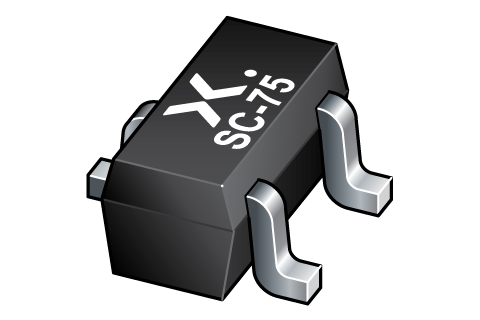
Register once, drag and drop ECAD models into your CAD tool and speed up your design.
Click here for more informationBAS116T
Single low leakage current switching diode
Single low leakage current switching diode, encapsulated in an ultra small SOT416 (SC-75) Surface-Mounted Device (SMD) plastic package.
Features and benefits
- High switching speed: trr = 0.8 µs
- Low leakage current: 3 pA
- Repetitive peak reverse voltage: VRRM ≤ 85 V
- AEC-Q101 qualified
- Low capacitance: Cd = 2 pF
- Reverse voltage: VR ≤ 75 V
- Ultra small SMD plastic package
Applications
- Low leakage current applications
- General-purpose switching
- Voltage clamping
- Reverse polarity protection
参数类型
| 型号 | Package version | Package name | Size (mm) |
|---|---|---|---|
| BAS116T | SOT416 | SC-75 | 1.6 x 0.75 x 0.9 |
封装
下表中的所有产品型号均已停产 。
| 型号 | 可订购的器件编号,(订购码(12NC)) | 状态 | 标示 | 封装 | 外形图 | 回流焊/波峰焊 | 包装 |
|---|---|---|---|---|---|---|---|
| BAS116T | BAS116T,115 (934063959115) |
Obsolete |

SC-75 (SOT416) |
SOT416 | SOT416_115 |
文档 (5)
| 文件名称 | 标题 | 类型 | 日期 |
|---|---|---|---|
| BAS116T | Single low leakage current switching diode | Data sheet | 2012-07-10 |
| AN90063 | Questions about package outline drawings | Application note | 2025-03-12 |
| Nexperia_package_poster | Nexperia package poster | Leaflet | 2020-05-15 |
| SOT416 | plastic, surface-mounted package; 3 leads; 1 mm pitch; 1.6 mm x 0.75 mm x 0.9 mm body | Package information | 2025-01-31 |
| BAS116T | BAS116T SPICE model | SPICE model | 2025-04-07 |
Longevity
The Nexperia Longevity Program is aimed to provide our customers information from time to time about the expected time that our products can be ordered. The NLP is reviewed and updated regularly by our Executive Management Team. View our longevity program here.
模型
| 文件名称 | 标题 | 类型 | 日期 |
|---|---|---|---|
| BAS116T | BAS116T SPICE model | SPICE model | 2025-04-07 |
How does it work?
The interactive datasheets are based on the Nexperia MOSFET precision electrothermal models. With our interactive datasheets you can simply specify your own conditions interactively. Start by changing the values of the conditions. You can do this by using the sliders in the condition fields. By dragging the sliders you will see how the MOSFET will perform at the new conditions set.